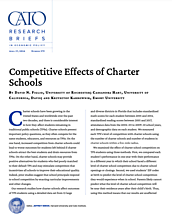Charter schools have been growing in the United States and worldwide over the past two decades, and there is considerable interest in how they affect students remaining in traditional public schools (TPSs). Charter schools present important policy questions, as they often compete for the same students, educators, and resources as TPSs. On the one hand, increased competition from charter schools could lead to worse outcomes for students left behind if charter schools attract the best students and drain resources from TPSs. On the other hand, charter schools may provide positive alternatives for students who feel poorly matched to their default TPS and may stimulate competition that incentivizes all schools to improve their educational quality. Indeed, prior studies suggest that school principals respond to school competition by enacting curricular improvements and other changes.
Our research studies how charter schools affect outcomes of TPS students using a detailed data set from 12 large and diverse districts in Florida that includes standardized math scores for each student between 2001 and 2014, standardized reading scores between 2001 and 2017, attendance data from the 2002-03 to 2009-10 school years, and demographic data on each student. We measured each TPS’s level of competition with charter schools using the number of charter schools and number of students in charter schools within a five-mile radius.
We examined the effect of charter school competition on TPS students using three methods. First, we compared each student’s performance in one year with their performance in a different year in which their school faced a different level of charter school competition due to charter school openings or closings. Second, we used students’ ZIP codes at birth to predict the level of charter school competition they would experience when in school. Parents likely cannot predict what the level of charter school competition will be near their residence years after their child’s birth. Thus, using this method means that our results are unaffected by parents with children of certain characteristics systematically choosing to live in places with high or low future charter school competition. Third, we compared the outcomes of siblings of different ages who attended the same grade in the same TPS in years with different levels of charter school competition. Comparing siblings accounts for family characteristics that affect children’s outcomes, such as parental expectations, preferences for nontraditional schools, and the ability to help with homework.
Our results using each method show that increased charter school competition improves reading test scores and reduces absenteeism of students remaining in TPSs. Specifically, the sibling method suggests that adding one charter school within five miles of a TPS improves average reading scores by 0.35 percent of a standard deviation and reduces absenteeism by 0.033 percentage points (0.74 percent of the average absenteeism rate). However, our research finds no evidence that charter school competition improves math outcomes. Our results rule out negative effects on math scores larger than 0.29 percent of a standard deviation and positive effects larger than 0.37 percent of a standard deviation.
The null finding on math scores is particularly notable because education research tends to find that school policies affect math scores but not reading scores. This is often explained by arguing that factors outside school, such as family involvement, are more important for reading outcomes while math outcomes tend to depend more heavily on in-school factors. Thus, our null findings for math scores are somewhat surprising and deserve further exploration.
Our results comport with recent public school achievement trends in Florida. The state has been singled out for relatively strong growth in well-established, low-stakes tests, such as the National Assessment of Educational Progress. While our results cannot account for all the improvement that Florida has seen over the past several decades, they do suggest that charter school competition may contribute to those results, at least for reading. However, our results do not guarantee that increasing charter school competition in other states will improve student outcomes. Moreover, our results may not hold in other parts of Florida not included in this analysis, though the 12 districts in our study appear to be representative of how charter school competition varies throughout Florida.
Note:
This research brief is based on David N. Figlio, Cassandra Hart, and Krzysztof Karbownik, “Competitive Effects of Charter Schools,” National Bureau of Economic Research Working Paper no. 32120, February 2024.

This work is licensed under a Creative Commons Attribution-NonCommercial-ShareAlike 4.0 International License.



